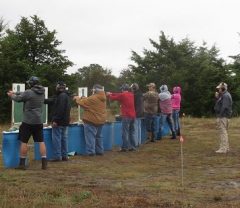Practicing marksmanship is like exercising; you know you should, but you’re always just so busy. However, it’s more fun than exercising! Regardless, getting into a routine makes it easier to accomplish something.
Start by finding a range that is reasonably on your way home from work, and buy a membership. Yes, I know it costs a few hundred dollars. What’s your life worth? I guarantee, when you realize you can go to the range for free, you won’t hesitate to go. Gyms sell memberships knowing that a certain percentage of members will stop going after a few weeks. That way, they can oversell the club, and make money. Like a gym, if a range member goes frequently, the cost per trip is much less than ala carte. My range loses money on me. Don’t tell them!
Try going to the range every Friday after work, just for 20 minutes. When you’re not paying for each session, it doesn’t matter how long you’re there. That alone will improve your shooting remarkably, as that represents 45-48 sessions a year instead of once every 3 months like some people. If you have more than one gun, alternate them, or take two. You do have more than one, don’t you?
Don’t forget dry-firing. If that can be part of a Seal Team’s routine, it can be part of yours. Most center-fire guns will not be harmed by dry-firing, but I always use snapcaps, just in case. Do two minutes of dry-firing before you start shooting, and maintain your stance and arm-extension throughout. This is a good way to improve your ability to focus your mental efforts on the muzzle, and keep it from moving. You can also do that at home. I have targets up at various places around the house, so I can practice varying distances. Guests find that odd, but what do I care? (Maybe that’s why nobody visits!).
Once you start shooting for real, think about the fundamentals. Foot position. Stance. Are you bending slightly at the waist? Leaning forward? Good arm extension? Those all contribute to focus, both physical and mental, and help you be serious about marksmanship.
Defensive shooting is typically thought of as two-handed, but once in a while, try shooting one-handed, both strong hand and support hand. This is harder than it looks, because most people find it difficult to move one finger (index) without affecting the rest of the hand, which causes the muzzle to move. Musicians learn this early on, as playing an instrument requires learning how to move one finger out of 4-9 without affecting the others, but most people never have to do this. It takes a little practice. Again, dry-fire practice on this is more economical, until you have a grip on it (so to speak). Is it possible you could be in a shooting incident, and be wounded in the arm of the strong hand? Yes.
Panic drill. If you can arrange to do this where you can draw from a holster, fine, but be careful. Most people who injured themselves with a gun do so while drawing from a holster, or re-holstering. Never use both hands to draw from a holster. Most commercial gun ranges don’t allow holsters, so in that case, just lay the gun on the bench, muzzle pointed downrange, in the condition in which you would carry it. That could be, no round in the chamber, safety on, decocked, or cocked and locked. Have a man-sized target in front of you, about 5 yards out. On a Go command, see how fast you can put two shots on the target. The goal is 3 seconds. Ten seconds and you’re dead. This also takes practice.
After all, if you’re going to spend money on a gun, you may as well be good at using it, just in case.
